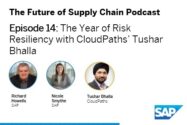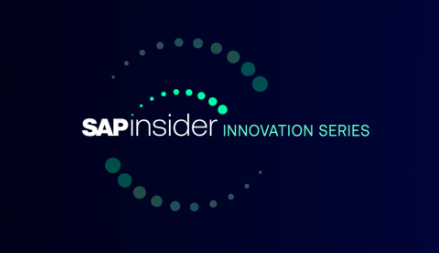SAP Supply Chain Management
SAP APO | SAP Asset Management | SAP Business Network | SAP Digital Manufacturing Cloud | SAP Digital Twin | SAP EWM | SAP IBP | SAP Inventory Management | SAP Label Printing | SAP Logistics | SAP Manufacturing | SAP Manufacturing Automation | SAP MES | SAP MII | SAP MM | SAP MRO | SAP MRP | SAP Order Management | SAP Plant Maintenance | SAP PLM | SAP Production Planning | SAP S&OP | SAP SD | SAP SPM | SAP Supply Chain Planning | SAP Track and Trace | SAP Transportation Management
Filter By
Browse By
- SAP Analytics and AI
- SAP Application Development and Integration
- All SAP Application Development and Integration
- SAP ABAP
- SAP ABAP Development Tools
- SAP ABAP Test Cockpit
- SAP API Management
- SAP BAPI
- SAP Basis
- SAP BRF
- SAP Business Application Studio
- SAP CMS
- SAP Design Studio
- SAP Development Tools
- SAP DevOps
- SAP EAI
- SAP EDI
- SAP Extension Suite
- SAP Fiori
- SAP Fiori Elements
- SAP Integration Suite
- SAP Low Code Application Development
- SAP Low Code Automation
- SAP Netweaver
- SAP Release Management
- SAP UI5
- SAP Web Application Server
- SAP Web IDE
- SAP Business Process Management
- SAP Center of Excellence
- SAP CIO
- SAP Customer Experience
- SAP Data and Data Management
- All SAP Data and Data Management
- SAP BW
- SAP BW/4HANA
- SAP Crystal Reports
- SAP Data Archiving
- SAP Data Center
- SAP Data Governance
- SAP Data Integration
- SAP Data Migration
- SAP Data Quality
- SAP Data Services
- SAP Data Strategy
- SAP Data Visualization
- SAP Data Warehouse Cloud
- SAP DMS
- SAP Document Control
- SAP EIM
- SAP ETL
- SAP ETL Tools
- SAP HANA
- SAP HANA Administration
- SAP HANA Deployment Infrastructure
- SAP HANA Studio
- SAP Master Data
- SAP Master Data Governance
- SAP MDM
- SAP Enterprise Architect
- SAP Enterprise Asset Management
- SAP ERP
- SAP Finance
- All SAP Finance
- SAP Accounting
- SAP AR AP
- SAP Asset Accounting
- SAP Billing Systems
- SAP BPC
- SAP BRIM
- SAP Cash Management
- SAP Central Finance
- SAP Controlling
- SAP COPA
- SAP Cost Center Accounting
- SAP Currency Risk
- SAP e-invoicing
- SAP FICO
- SAP Finance Automation
- SAP Advanced Financial Closing
- SAP Financial Consolidation
- SAP Financial Planning
- SAP FX Risk
- SAP General Ledger
- SAP Global Tax Management
- SAP Hyperion
- SAP Order to Cash
- SAP Payment Processing
- SAP Profitability Analysis
- SAP Rebate Management
- SAP S/4HANA Finance
- SAP SWIFT Compliance
- SAP Treasury Management
- SAP Universal Journal
- SAP Governance Risk and Compliance
- SAP Human Capital Management
- SAP Intelligent Technologies
- SAP Platform and Technology
- All SAP Platform and Technology
- SAP Business Technology Platform
- SAP Cloud
- SAP Cloud Connector
- SAP Cloud Integration Platform
- SAP Cloud Migration
- SAP Cloud Platform
- SAP Cloud Providers
- SAP Cloud Strategy
- SAP Digital Signature
- SAP Container Platform
- SAP HANA Enterprise Cloud
- SAP Digital Asset Management
- SAP Smart Forms
- SAP HEC
- SAP Digital Integration Hub
- SAP Hyperscalers
- SAP Infrastructure
- SAP Messaging
- SAP Quality and Testing
- SAP Security
- SAP Spend Management
- SAP Supply Chain Management
- All SAP Supply Chain Management
- SAP APO
- SAP Asset Management
- SAP Business Network
- SAP Digital Manufacturing Cloud
- SAP Digital Twin
- SAP EWM
- SAP IBP
- SAP Inventory Management
- SAP Label Printing
- SAP Logistics
- SAP Manufacturing
- SAP Manufacturing Automation
- SAP MES
- SAP MII
- SAP MM
- SAP MRO
- SAP MRP
- SAP Order Management
- SAP Plant Maintenance
- SAP PLM
- SAP Production Planning
- SAP S&OP
- SAP SD
- SAP SPM
- SAP Supply Chain Planning
- SAP Track and Trace
- SAP Transportation Management
- SAP System Administration
SAP Supply Chain: Supply Chain Management
A well-managed supply chain can significantly reduce a company’s operating expenses and increase profits. A supply chain requires active management because it is affected by many factors outside the control of the business. Current events causing global supply chain disruptions include the Russia-Ukraine War and the continuing effects of COVID-19.
SAP Supply Chain: Supply Chain Management
A well-managed supply chain can significantly reduce a company’s operating expenses and increase profits. A supply chain requires active management because it is affected by many factors outside the control of the business. Current events causing global supply chain disruptions include the Russia-Ukraine War and the continuing effects of COVID-19.
Supply chain management is the flow of goods or services between businesses and various locations to get goods to consumers faster and at less cost. Supply chain management encompasses a thread of activities from design and manufacturing to delivery and operations.
Components to enable a resilient and sustainable supply chain management process are:
- Designing recyclable and sustainable products
- Delivering products with low carbon impact
- Planning to reduce emissions and ethically source materials
- Operating in an energy efficient and safe manner
- Manufacturing with minimal waste and environmental impact.
Accurate information helps manufacturers and retailers produce and transport only what they can sell, eliminating unnecessary expenses. Consider simplification by integrating demand planning in the cloud. Predictive analytics, automation, and Internet of Things (IoT) technologies can connect and simplify processes, allowing you to gain visibility across forecasting, response and supply, replenishment, and inventory.
Key Capabilities of Supply Chain Management:
- Supply Chain Planning: Agile market-driven plans with visibility, collaboration, and intelligence.
- Supply Chain Logistics: Fast, efficient, and sustainable logistics.
- Manufacturing: Streamlining with artificial intelligence, loT, and integration.
- Product Lifecycle Management: Connecting systems, people, and processes with end-to-end digital innovation.
- Enterprise Asset Management: Improving asset performance and reliability.
Benefits of Supply Chain Management:
- Optimizing the flow of materials, products, and information.
- Improving data visibility.
- Enhancing financial practices and cost cutting.
- Improving vendor relationships.
- Operating with lean and on-demand inventory.
- Reducing liability and risk.
Key Considerations for SAPinsiders
- How to Deliver Greater Visibility into the Operational KPIs that Drive Your Business. In this webinar, hear insights from SAP around how to build a powerful analytics foundation. Discover how to focus less on historical KPI’s and more on predictive process automation, how to reprioritize KPIs that show historical performance, develop operational decision support for end-to-end supply chain processes, and stop development of custom reporting.
- 5 Ways to Enhance Your SCM with Smart Data. Explore expert insights from Robert Brice, President and CTO, RFgen. Start with the basics for a digital transformation of your supply chain, discover how to gain competitive advantage by implementing efficiencies, address inefficiencies, shortage of labor, and address security.
- Salling Group Expands Its Market Reach With SAP. In this article, see how Salling Group used SAP ERP to ensure data uniformity, enhance warehouse efficiency, and consolidated logistics transactions with Redwood.
558 results
-

- SAP Procurement
 Premium
Premium
An Analysis of Simplified Sourcing on SAP S/4HANA
Reading time: 11 mins
Learn the differences between the material requirements planning (MRP) source of supply determination in SAP ERP and the simplified sourcing logic introduced in SAP S/4HANA. Key Concept Source of determination is the process of selecting a source of supply. This process can be executed by material requirements planning (MRP) when a replenishment proposal is created....…
-

 Premium
Premium
Ask the BW Expert: Event Chains vs. Subsequent Processing Functionality
Reading time: 3 mins
Confusing BW event chains with their subsequent processing functionality is a common mistake. The author explains the differences and shows how SAP has replaced event chains with process chains in BW 3.x. Dear BW Expert; Does BW 2.x have a report that lists all event chains with job names, InfoObject names, dependent jobs, and so...…
-

 Premium
Premium
SAP BusinessObjects Planning and Consolidation: An Overview of What to Expect When Upgrading from SAP BPC 5.1
Reading time: 22 mins
Take a high-level look at the updates in SAP BusinessObjects Planning and Consolidation, version for SAP NetWeaver. See how the new functionality compares to functionality previously offered in version 5.1 and how these changes affect reporting, data transfer modeling, and data and transport management. Key Concept SAP BusinessObjects Planning and Consolidation is a part of...…
-
-

Digital Transformation in a Nutshell
Reading time: 2 mins
Blue Diamond Growers digital transformation from a disjointed, multi-system spreadsheet supply chain approach to a fully integrated, cloud-based solution that provides a single source of truth for demand and supply planning.
-

How can users come up for air in a permacrisis? EY talks manufacturing and supply chains
Reading time: 7 mins
Manufacturers and supply chains are feeling the permacrisis pressure. EY’s global consulting head of SAP, Dr. Tom Janoshalmi, shares how users can resurface from the slump. Membership Required You must be a member to access this content.View Membership LevelsAlready a member? Log in here
-

Automation Through Cloud Labeling for Transparency and Product Safety
Reading time: 2 mins
AI and automation are revolutionizing the food and beverage supply chain, particularly in areas like inventory management, demand forecasting, and decision-making. By leveraging cloud technology, these innovations can automate complex processes, ensure product quality, and provide real-time visibility, which is crucial for managing perishable goods. However, successful implementation depends on strategic planning and seamless data…
-

 Premium
Premium
Accurate Order Promising through Global ATP in a Consolidation Environment
Reading time: 29 mins
Learn how to implement rules-based available-to-promise (ATP) in a consolidation scenario including the use of multi-level ATP. Key Concept Fixed pegging is the process of establishing the relationship of a receipt document to the requirement document it fulfills. This linkage is not broken when receipts or requirements are rescheduled in time or through a planning...…
-
-

- SAP Supply Chain Management
 Premium
Premium
5 Ways to Enhance Your SCM with Smart Data Collection
Reading time: 5 mins
For manufacturers and warehouses, the supply chain is constantly top of mind. As transportation costs soar and warehouse managers grapple with the need for more space, digitally transformed inventories have proven to be the way forward. Modernization and streamlined technology contribute to overall operational efficiency, driving stronger business models and quicker delivery mechanisms. After all,…
-

The Future of Supply Chain: The Year of Risk Resiliency with CloudPath’s Tushar Bhalla
Reading time: 1 mins
Since the start of the pandemic, risk-resiliency has been a driving force in companies’ supply chain transformations. CloudPath’s Tushar Bhalla joins us on the series to discuss how technology is changing how companies proactively predict. Risk-Resiliency has become a topic that supply chain executives have not only built into their supply chains but become a…
-

SAP Extended Warehouse Management – Enhanced Automation and Visibility for Warehouse Management
Reading time: 2 mins
Basis Technologies, an experienced SAP implementation partner assists companies in their supply chain transformation journey. Through Basis Technologies’ ActiveDiscover and its EWM extension, companies can maintain high data quality to make informed, data-driven design decisions.
Become a Member
Unlimited access to thousands of resources for SAP-specific expertise that can only be found here.
Become a Partner
Access exclusive SAP insights, expert marketing strategies, and high-value services including research reports, webinars, and buyers' guides, all designed to boost your campaign ROI by up to 50% within the SAP ecosystem.
Upcoming Events
Related Vendors
Your request has been successfully sent


